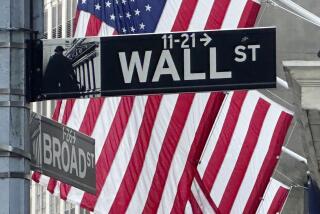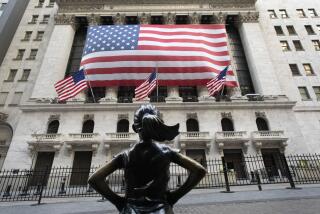Dollar Takes a Big Tumble Against Yen on Rate Worries
- Share via
TOKYO — As U.S. interest rates held firm and speculation grew that Japanese rates will climb, the dollar’s fall against the yen accelerated sharply Tuesday to a five-month low on traders’ expectations of a narrower interest rate spread between the two countries.
The dollar fell as low as 111.98 yen in Tuesday afternoon trading here, down 3.62 yen from its New York close Monday--and down 12% from a nearly five-year high of 127.47 on May 1. By Tuesday’s U.S. close, the dollar stood at 113.04 yen. In early Tokyo trading today, it was at 113.18.
The dollar’s unexpectedly steep one-day fall was initially triggered in Tokyo by reports that the ruling Liberal Democratic Party will urge the Bank of Japan to raise interest rates. Underlying that was traders’ growing concern about Japan’s surging trade surplus.
The plunge was fueled later Tuesday after the U.S. central bank’s meeting of the Federal Open Market Committee ended with no announcement, indicating no change in interest rates.
The greenback fell against other major currencies as well, closing down 3 pfennigs to 1.6760 German marks, from 1.7080 late Monday. It closed at 1.3870 Swiss francs, down from 1.4275.
“The dollar is getting hit. We are going down hard,” said Marc Chandler, senior currency analyst at Deutsche Morgan Grenfell, as the dollar began its slide.
Japanese policymakers want higher interest rates to head off a risk of accelerated capital flight overseas and provide better returns to Japanese savers. Such a policy could be politically popular, as bank accounts here currently yield less than 1%.
“The current low interest rate situation is negatively affecting pensioners,” said Koko Sato, head of a Liberal Democratic reform committee. “It could also invite further fund outflow from the domestic market to high-yielding overseas asset markets.”
Japan’s official discount rate, which provides a benchmark for other interest rates, has been at a record low annual rate of 0.5% since September 1995. The low rate played a key role in a dramatic 60% appreciation of the dollar between April 1995 and May 1 as investors chased the dollar’s higher return. It also helped banks here achieve strong operating profits, which has helped them write off some of the bad loans plaguing the banking system.
But the weaker yen has also led to a rapid rise in Japan’s trade surpluses by making its exports more competitive. Japan’s global trade surplus soared nearly 164% in April compared with a year earlier, while its surplus with the United States soared 174.1% to $4.1 billion.
Concern here over the latest trade figures was deepened by warnings Monday from U.S. Treasury Secretary Robert Rubin that any “sustained increase” in Japan’s trade surpluses would be “a very serious problem.” Rubin’s comment was taken to mean that he would welcome a further decline in the dollar.
Wall Street’s favorable reaction to the plunging dollar helps explain Rubin’s position: It is good news for U.S. export industries such as autos. On Tuesday, General Motors shot up $1.625 to $57.50, Ford Motor gained $1.125 to $37.50 and Chrysler added 50 cents to $31.50. By the same token, it is bad news for Japanese export industries such as autos. By Tuesday afternoon, Japanese officials appeared to be trying to rein in the yen’s surge, which they had previously favored to help keep trade surpluses under control.
Eisuke Sakakibara, a Finance Ministry bureaucrat known as “Mr. Yen” due to his influence on exchange rates, was more blunt, warning that the yen’s recent movement was “too wild.” He also said that “economic fundamentals” will block the yen from continuing its rapid appreciation.
Sakakibara had set off the yen’s recent surge with a May 8 statement that the dollar could “theoretically” fall to 103 yen within a year.
Reuters contributed to this report.
More to Read
Inside the business of entertainment
The Wide Shot brings you news, analysis and insights on everything from streaming wars to production — and what it all means for the future.
You may occasionally receive promotional content from the Los Angeles Times.










